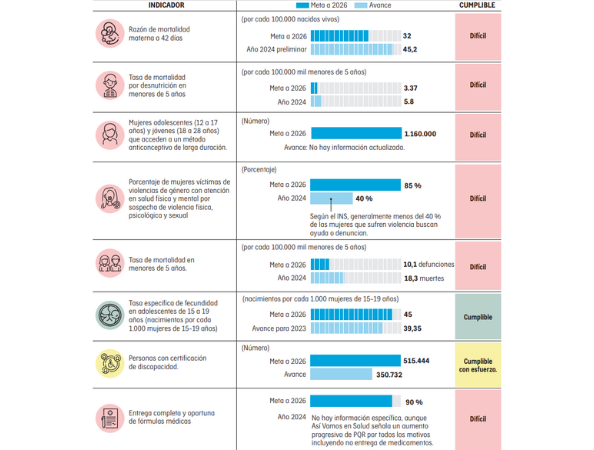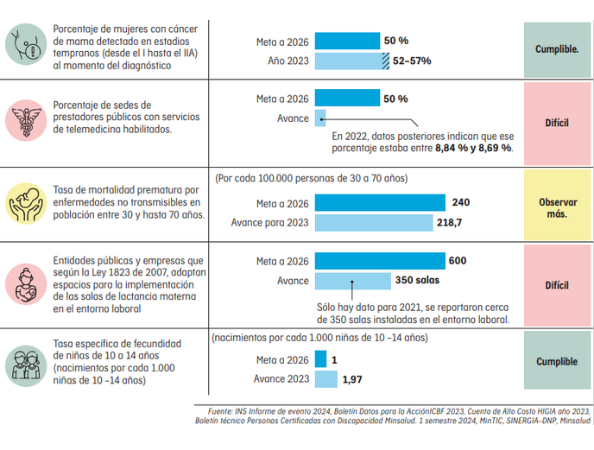Of 13 health goals, only 4 are achievable

As President Gustavo Petro's administration completes three years, the health sector finds itself at a time of profound discussion and challenges. While health reform has been the central theme of political and social debate, it is essential to assess the progress and setbacks made in the main public health goals, using the monitoring indicators of the National Development Plan (PND) "Colombia, a World Power for Life," through the Sinergia application of the National Planning Department (DNP) and data from the National Institute of Health (INS). Although the plan was not formulated by sector, but rather through strategic goals, the government committed to 13 goals and 13 indicators in health. We monitor these goals through the Public Health Observatory of the University of the Andes.
It is important to note that there is no evidence of rigorous monitoring by the National Planning Department. Many of the compliance percentages, even above 100%, correspond to specific processes or activities, but do not reflect monitoring of population indicators.
Of the 13 specific health goals for which the Ministry of Health and its affiliated entities are responsible, eight are difficult to achieve by 2026, especially in this final year of government, given a serious health crisis that is increasing access barriers and untimely preventive and medical-surgical care. According to the assessment, four goals are achievable or achievable with effort, and one goal, which refers to chronic non-communicable diseases, requires more monitoring by the health sector.
Maternal mortality ratio: an indicator of equity and access Maternal mortality is one of the most sensitive indicators of the state of a health system. Its reduction depends not only on the quality of medical care, but also on access to timely health services and territorial equity. The National Development Plan (NDP) goal is to reduce the maternal mortality ratio to 32 deaths per 100,000 live births.
According to DNP data, progress toward this goal is 9.24% as of December 2023. INS data show a downward trend in the maternal mortality ratio nationwide, falling from 46.0 in 2022 to 44.5 in 2023. However, the territorial analysis reveals worrying disparities. The presentation shows a high concentration of maternal mortality in departments such as La Guajira, Chocó, and Valle del Cauca, where rates far exceed the national average. This highlights the need to focus efforts and resources on the most vulnerable regions, addressing geographic and cultural access barriers, and strengthening the primary care network in these areas. Progress toward the goal has been slow, and the regional gap remains a significant challenge.

Technical Bulletin on Certified Persons with Disabilities, Ministry of Health. First semester 2024. Photo: Ministry of ICT, SINERGIA-DNP, Ministry of Health
Malnutrition in early childhood is a public health problem that has long-term consequences for children's physical and cognitive development. The National Development Plan (PND) goal is to reduce the mortality rate due to malnutrition in children under 5 years of age to 3.37 per 100,000 children under 5 years of age.
The progress reported by the National Directorate of Public Health (DNP) is 26.99% as of December 2023. Although INS data show a decrease in the number of deaths from acute malnutrition in children under 5 years of age between 2023 and 2024 (from 288 to 211), the mortality rate remains high in some regions of the country. This indicator is directly related to food security and socioeconomic conditions, so its improvement depends on intersectoral interventions that go beyond the health system. The government's response must be comprehensive, strengthening school feeding programs, access to drinking water, and basic sanitation, especially in rural areas and the most affected territories.
Under-5 mortality rate: an indicator of child well-being The National Institute of Statistics (DNP)'s progress for this indicator is 19.69% as of December 2023. The National Institute of Statistics (INS) presentation shows a downward trend in the mortality rate among children under 5 years of age due to acute respiratory infection (ARI), acute diarrheal disease (ADD), and acute malnutrition (AMD), the leading preventable causes of death in this population. The national mortality rate among children under 5 years of age was 18.3 deaths per 100,000 children under 5 years of age in 2024. Despite the progress, this figure remains a challenge and requires greater efforts in primary care, vaccination, and health education for families. Reducing these deaths is a priority that must be strengthened to ensure the healthy development of future generations.

Technical Bulletin on Certified Persons with Disabilities, Ministry of Health. Photo: Ministry of ICT, SINERGIA-DNP, Ministry of Health
Noncommunicable diseases (NCDs) such as diabetes, hypertension, cancer, and cardiovascular disease are the leading cause of death in the country. The National Development Plan's goal is to reduce the premature mortality rate from NCDs to 240.
National Planning shows a progress of 660.53% toward this goal as of December 2023, which suggests that the target has been far exceeded; however, this does not correspond to reality. Chronic non-communicable diseases are the leading cause of morbidity and mortality in Colombia and are where the least information is available.
Final conclusion Three years into the Petro administration, the health situation is mixed. Progress has been made in reducing adolescent fertility. However, in key indicators such as maternal mortality and child malnutrition, challenges persist and regional gaps are evident.
eltiempo





